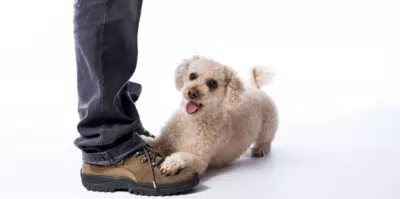How to Help a Dog With Anxiety
- 21 Dec 2019
- 5m read

Like lots of humans, dogs are creatures of habit. They thrive on knowing what to expect and love to have a routine. So if your pooch is used to 9am being cuddle-o'clock and 3pm being playtime, don't think you'll get away with changing things. An anxious dog will feel better if you make sure that their walks, meals and all aspects of their daily life are as routine as possible.
Symptoms of Anxiety in Dogs
Some of the common symptoms in dogs which may be suffering from anxiety include:
• Pacing
• Shaking
• Barking
• Chewing
• Weeing indoors
Why is My Dog Anxious?
Lots of things can trigger anxious behaviour in dogs. Some are common (fireworks or thunderstorms) while others can be a bit more, well, peculiar (a fear of motorcyclists or the sight of their own reflection).
Some dogs are more anxious than others and this is often linked to missed socialisation opportunities during puppyhood. The first few months of a pup’s life are called the ‘socialisation period.’ This is when they need to experience a wide range of sounds, sights and situations so that they learn to take them in their stride as they grow up. Unfortunately, dogs who miss out on being properly socialised can end up with a range of fears or phobias.
How to Calm an Anxious Dog
A decade ago, if you’d told the general public that you had a dedicated music playlist to help calm your dog down, they would have thought you were absolutely bonkers. Fast forward to a new generation of pet parents that hold their dogs in as high regard as their babies, and it’s simply the norm.
Music has been proven as an effective method for soothing dogs. It can be used in a multitude of ways, such as playing it when you leave your dog home alone, when travelling in the car or perhaps during thunderstorms. We would advise playing this kind of music under normal circumstances too, so that your dog doesn’t always associate it with something scary happening.
Even Battersea Dogs Home adopt this method when Bonfire Night rolls around, in addition to blocking out the windows and using aromatherapy sprays.
How to Help a Dog with Separation Anxiety
Separation anxiety is one of the best-recognised dog anxieties. Pooches with this problem will get stressed and anxious when they're left on their own. One effective way to help relieve this anxiety is to avoid making a big fuss when you leave the house or come home. Aim to keep the whole process of going out as calm and unremarkable as possible. Don't give them a huge 'goodbye' cuddle, or take ages getting all your stuff together. That way your dog will quite rightly understand that there's nothing to worry about when you go out.
To help your dog beat separation anxiety, begin by rewarding them with a calm greeting when they've spent even very short amounts of time without you. Aim to gradually build up their alone time, reassuring them that you always come back. Creating a snug den and leaving them with a T-shirt carrying your scents to cuddle up with can help them to feel relaxed. Or you could try a plug-in diffuser (called a 'dog appeasing pheromone' – or DAP – diffuser), that emits a calming natural chemical.
It also helps to take your dog on a long walk before leaving them for long periods of time. They are less likely to tear your house apart or howl if they’re too tired to even lift their head.
How to Ease Dog Anxiety on Walks
Dogs that have anxiety on walks can be born out of lots of different reasons. They may have been previously attacked by another dog, or they’re simply just very timid. Whatever the reason, there’s plenty of things you can do to get them loving the great outdoors again.
• Try to understand what it is that triggers your pooch. If it’s traffic for example, then it would make sense to opt for routes that are more quiet and secluded.
• Once you have found a route that works, stick to it as much as possible. At least to start with anyway, as their confidence builds up you can start to make slight changes.
• Bring treats along. Positive reinforcement is the perfect way to reassure your pooch that they’re doing a good job.
• Work with behaviourists and trainers. If all other options run out, it might be time to bring in the professionals to help you get to the root cause and develop a plan to overcome their fears.
How to Ease Anxiety with Loud Noises
To help your pup cope with fireworks or thunderstorms, make a hidey-hole location where they can go to feel safe and secure. Choose a spot where they would naturally go to retreat, such as under a table. Leave tempting treats in the 'refuge' to encourage your dog to go there, draw the curtains and introduce distracting background noise with the TV or radio.
If your pooch gets a bit scaredy-dog when the bangers go off, it's important not to cuddle or overwhelm them with sympathy. This is a sure-fire way to reinforce fearful behaviour. Instead, act normally and praise them when they're calm.
Butternut Box is Here to Help With Anxiety
Here at Butternut Box, we strive to do everything we can to ensure that your pooch is happy and healthy. That’s why we’ve developed treats that are specifically designed to aid relaxation.
We’ve harnessed the soothing magic of meadow milk to create a calming chew that’s naturally built to last for yonks. Cue our Yonks Bar. Meadow milk comes from farms where the cows are free to roam in meadows for at least 120 days each year, from springtime through to the autumn, and for at least 6 hours a day. Because happiness and healthiness needs to come right from the source.
For a twist on the classic, we have Pop Puff Crunchies. To make these delightfully crunchy treats, we take little pieces of our Yonks Bars, and gently heat them until they pop up into golden puffs. Just like that, Pop Puff Crunchies are born. Think of them like Yonks Bars' crunchier cousin, only they definitely won't last for yonks. Same great ingredients, same mellow pooch.




.png)